In youth baseball, you need to keep in mind that your local league’s affiliation with a national national charter (i.e. Little League, Babe Ruth/CalRipken, PONY, etc.) will determine the playing field for the particular age group.
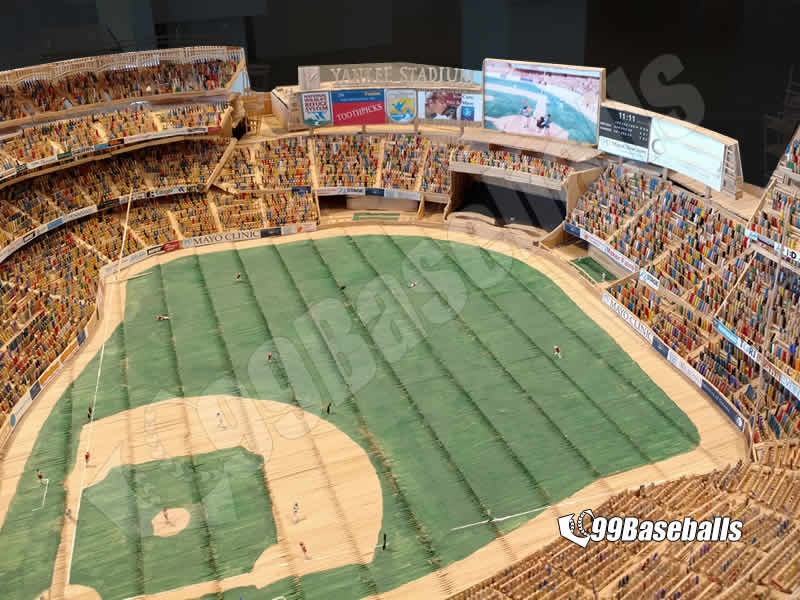
- Small Field is commonly defined as a 46/60 field (46 feet = pitching distance; 60 feet = base path)
- Medium Field is known as the 50/70 field (50 feet = pitching distance; 70 feet = base path)
- Big Field is referred to as a 60/90 field (60’6″ = pitching distance; 90 feet = base path)
You can interchangeably referred to each field size by their name or number (i.e. small field or 46 60)
Table of Contents
- Baseball Field Layout
- Pitching Mound
- Pitching Rubber
- Pitching Mound Accessories
- Home Plate Dimensions
- General Baseball Field Dimensions Per Age Group
- Baseball Field Dimensions Per League / Divisions
- American Amateur Baseball Congress (AABC)
- American Legion
- Babe Ruth / Cal Ripken
- Dixie League Baseball Field Dimensions
- Little League Baseball Field Dimensions
- PONY League Baseball Field Dimensions
- USSSA League Baseball Field Dimensions
- High School, College, MiLB and MLB
- Softball Field Dimensions Per Age Group
- Frequently Asked Questions
- Fun Facts
- Reference Links
Introduction
From sandlots to 60×90 baseball fields, the memory of stepping on that dirt infield for the first time is something that kids (and parents) will remember forever.
With a smell of fresh cut grass in the air with dandelions popping up all over the place, nothing beats the first crack of a bat or shuffling noise of child running down the baseline or playing their very first night game under the lights.
The primary purpose of this post is to review baseball field dimensions and components and present you with an abbreviated field dimensions.
A baseball field, also commonly referred to as a ball field, ball park, sandlot or baseball diamond, is the field where baseball game is played.
The field is broadly broken down to infield and outfield where an infield contains the home plate, three bags (one bag for each base) and a pitcher’s mound
Who created the baseball diamond?
Initially created by Alexander Cartwright Jr. (1820-1892) of the NY Knickerbocker Baseball Club in 1945 (Cartwright also formalized the modern baseball rules), the shape of a baseball diamond has stayed remarkably the same, though there are some differences between fields used by youth baseball players.
Why is baseball field more commonly referred to as a baseball “diamond”?
The infield is technically a square rotated 45 degrees but from the prospective of an umpire, catcher or batter, the field does resemble a diamond shape.
Besides, referring a baseball field as a diamond probably garnered more interests from the folks who were just beginning to learn about baseball (i.e. “baseball square” sounds bit dorky).
Baseball field sizes are represented by two numbers?
When someone says, “Hey, is our big field available tonight” or “Is our 60 90 field available for practice tomorrow”, the field size they are referred to is:

- The first number indicates the distance from pitching rubber to home plate is 60 ft 6 inches
- The second number indicates the distance between bases (home plate to first base or second to third or third to home) is 90 ft
| Fun Fact |
|---|
| The last time the pitching mound was moved was in 1893 where they moved backed from 50 feet to 60’6″ in response to pitchers taking advantage of “fast pitching”. The myth is that it was easier to remember the odd distance rather than a simple number. |
Baseball Field Layout
A baseball fields is divided into two majors sections: infield and outfield.
For the most part, it does not matter if you are playing on a small field, medium field or big field, components that make up the infield does not change (other than size).
The only exception is the warning track which are usually found only on 60/90 fields.
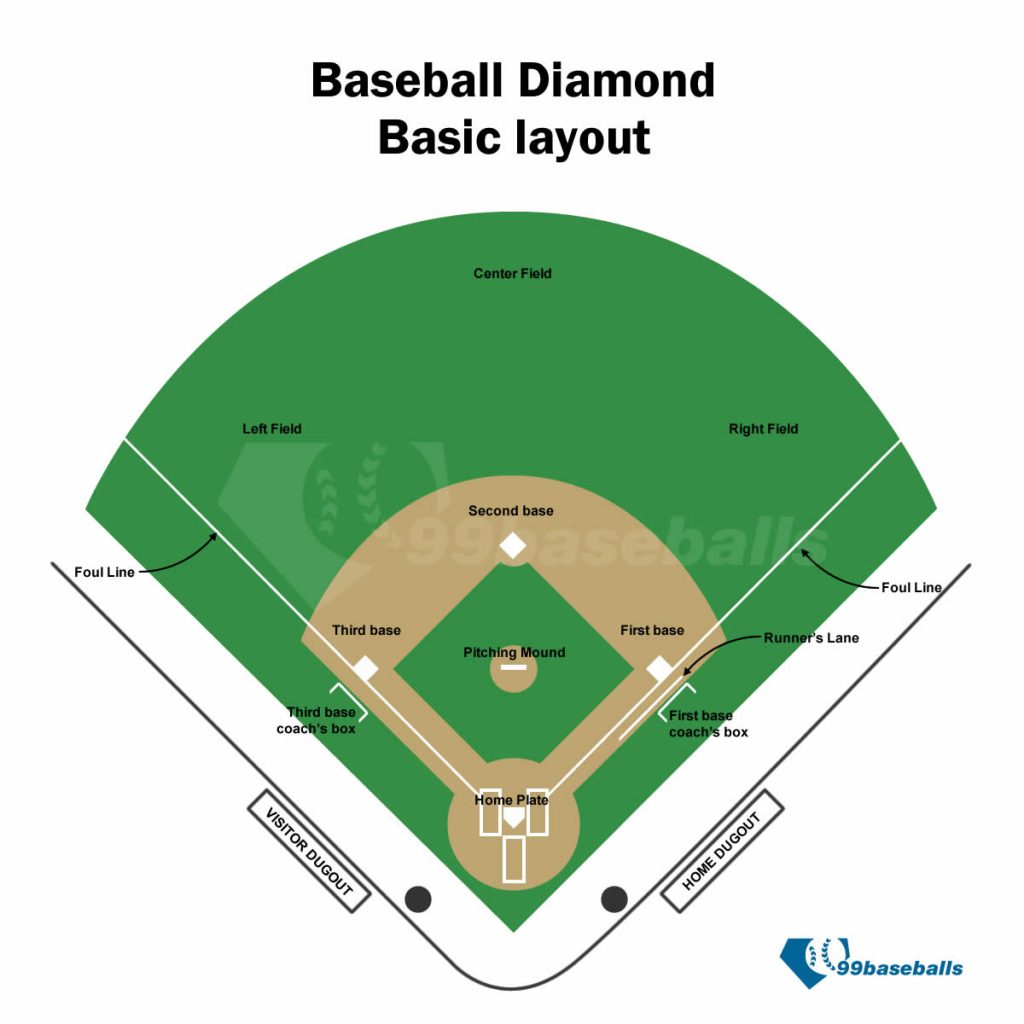
Outfield
Outfield consists of left, center and right fielder positions. Most 60×90 fields will also have a warning track which is used by outfielders to indicate how far they are from the fence (crunching sound gives an audible alert).
Although MLB has a set of minimum requirements, the overall shape of a baseball field can vary greatly. Just think of the Red Sox Fenway Park or Astro’s Minutemaid field with their green monster board and score walls, respectively.
The shape of a baseball outfield at the college, high school and younger leagues can get even more crazy.
Infield
Except in T-ball (where most games are played on a sandlot or similar ball fields), baseball fields will usually have most, if not all of the following components:
- Batter’s boxes (for right and left handed hitters)
- Catcher’s box
- Coach’s box – designated area for first base and third base coaches
- Distance between bases – Baseline (or base path) which is a straight line between two adjacent bases and/or home plate
- Dugouts – in most cases, the home team takes the dugout by the first base
- Foul Line – lines extend from both left and right batter’s box
- Home Plate – size is universal regardless of an age-specific field
- On-deck circle – non-professional leagues have a fenced in on-deck circles inside the dugout
- Pitching Mound – the overall dimension and slope varies between age groups
- Runner’s Lane or Running Lane is only marked between Home Plate and First Base; it is approximately 45 feet long (the last half)
Pitching Mound
Pitching mound, or pitcher’s mound, is a low artificial hill located in the middle between first and third base where a pitcher stands and throws his pitches.
In the Major League Baseball, this “hill” is 18 feet (5.5 m) in diameter, with the center 59 feet (18 m) from the rear point of home plate.
| Random Musings |
|---|
| Have you wondered how many baseball gams are played in a season? Are the identical across MLB and MiLB? What about NCAA? High school or youth baseball? Check out my post How Many Baseball Games in a Season to learn more! |
Six inches (15 cm) in front of the pitcher’s rubber, the mound begins to slop downward and the top of the rubber is to be no higher than ten inches (25 cm) above home plate.
A pitching mound in youth baseball is similar but not quite the same.
Instead of a 18 ft diameter, most youth fields have 16 ft diameter pitching mounds with a mound that is about 8 inches tall.
Because available fields for youth baseball and softball games are limited and dictated by location, most leagues publish facility guidelines to help local organizations develop their playing fields.
On a side note, be aware that pitching mound is notoriously difficult to maintain as it is the most heavily used part of the field after batter’s box so the height will vary greatly, especially during the latter part of a season.
Lastly, if your league plays both baseball and softball games on a same field (or maybe you are sharing a soccer turf field), you may see a portable pitcher’s mound that looks something like this:
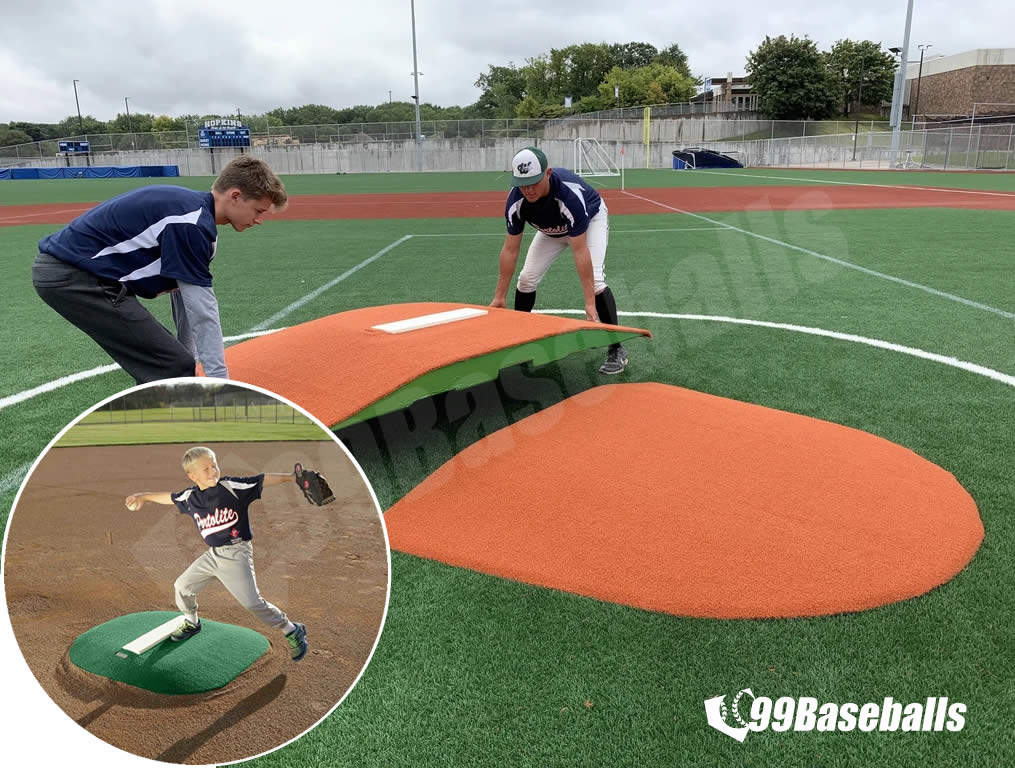
A removable (portable) mound is usually called a “turtle” where it is simply placed into place by several adults when needed.
Depending on your league, you may see a smaller version for younger players and larger (and very heavy) portable mounds for older players.
When kids reach 13u (a.k.a. 13 years old), they typically move onto a 60×90 baseball field with a permanent mound.
Pitching Rubber
A pitching rubber (a.k.a. pitcher’s plate) is a flat rectangular slab made of whitened hard rubber (used to be made from wood) on top of the pitcher’s mound.
All baseball pitchers, regardless of the age, must touch this rubber while beginning his/her throwing motion.
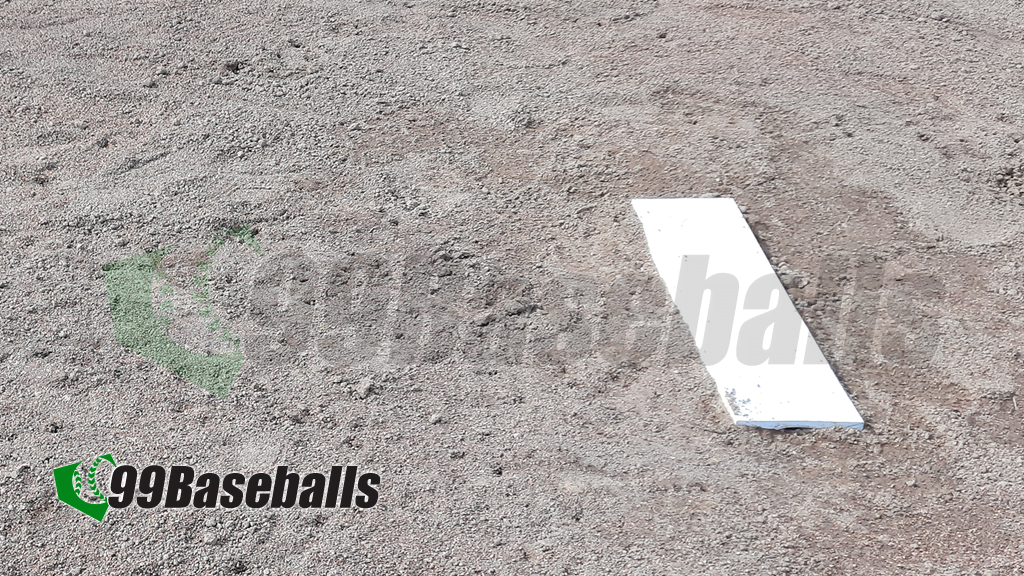
Most pitchers work from the center of the rubber, using it to push off with their back foot to obtain additional velocity on their pitches.
Few pitchers work from the side of the rubber, however, maintaining contact with the side of their foot while starting their motion; this allows them to throw a pitch coming from an angle which is uncomfortable for the batter.
The rubber’s dimension is 24 inches (61 cm) by 6 inches (15.24 cm), according to section 1.07 of the MLB rules.
In Major Leeague Baseball, a pitching rubber is set so that its front edge is exactly 60 feet 6 inches from the rear point of home plate, and is elevated 10 inches above the rest of the playing field. The area surrounding the mound is flat.
Pitching Mound Accessories
A pitcher may keep a “rosin bag” on the rear of the mound to dry off his hands (rosin bag is a small canvas bag filled with rosin powder which consists of sticky substance extracted from the same of fir trees; rosin bag is used to pitchers to improve their grip on the baseball and keep their hands dry).
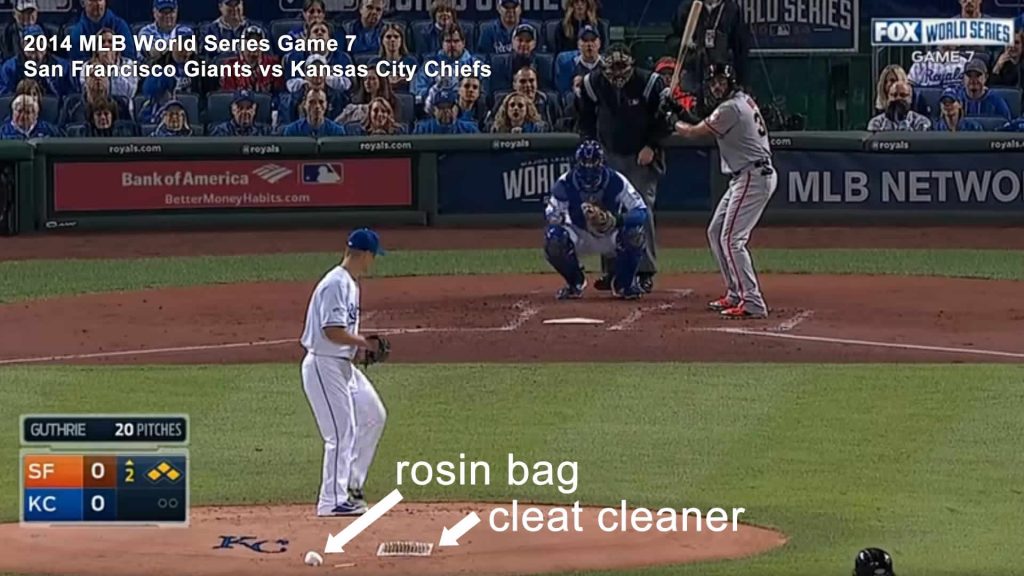
Although rare in youth baseball, all Major League Baseball teams are also permitted cleat cleaners on the back of the mound. This may be a flat grate-style plate, or simply a hand tool such as a piece of wood used to remove mud and dirt from cleats.
Both a rosin bag and clear cleaner are allowed to remain on the backside of the mound at the discretion of the umpire, thus reducing the probability that they will affect a live play.
Home Plate Dimensions
According to MLB’s Official Baseball Rules, home base (or home plate) is marked by a five-sided slab of whitened rubber that is 17-inch (43.18 cm) square with two of the corners removed so that one edge is 17 inches long, two adjacent sides are 8.5 inches (21.59 cm) and the remaining two sides are 12 inches (30.48 cm) and set at an angle to make a point.


Unlike other parts of a baseball field, the home plate dimension is universal.
Interesting Facts about a Home Plate
- It is set in the ground with the point at the intersection of the lines extending from home base to first base and to third base; with the 17-inch edge facing the pitcher’s plate, and the two 12-inch edges coinciding with the first and third base lines.
- In order to reduce injury risk during sliding, the top edges of home base is beveled and the base is fixed in the ground level with the ground surface
- Three bases are 15″ square each that are 3 to 5 inches thick. These bases are designed to be “ripped” off to minimize injury, unless you are playing on an adjustable turf field.
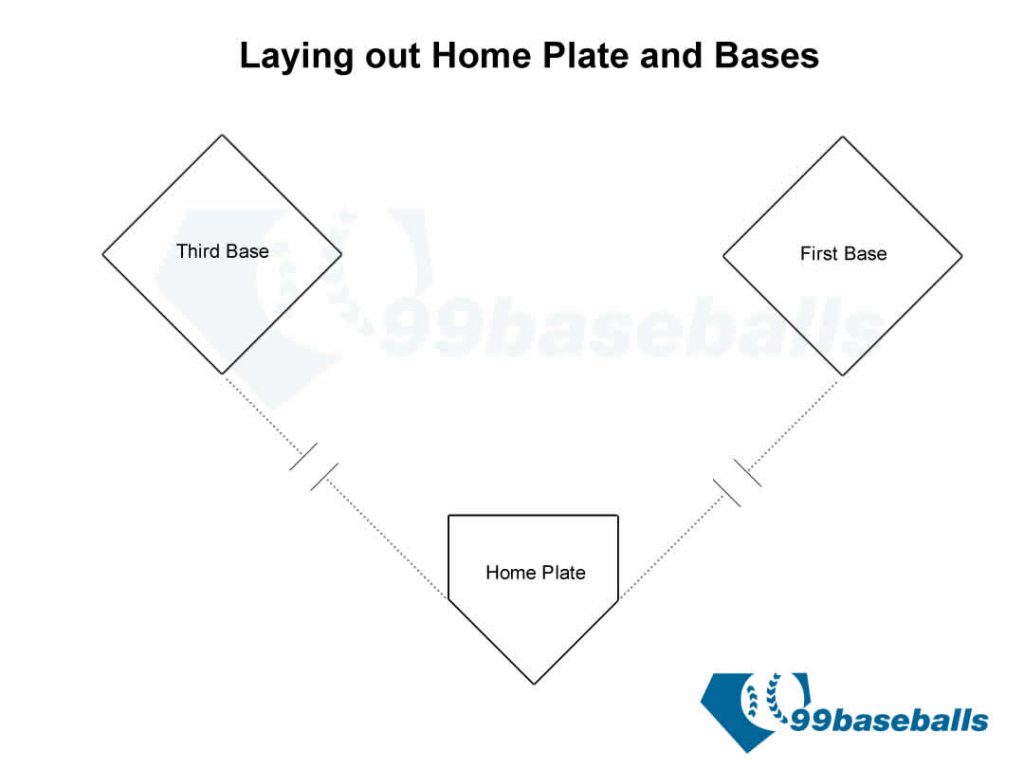
General Baseball Field Dimensions Per Age Group
If you overlook the age specific requirements per league, we can breakdown the age group into three distinct groups:
- Ages 3-9: players in this age group usually share a 46×60 field with t-ball players using throwdown bases to shorten the base path
- Ages 10-12: players in this age group use 50×70 field
- Ages 13+: this is the year most middle-school aged kids start playing on a big field (60×90)
For more detailed information age-specific field sizes, please read Distance Between Bases – Baseline Measurements
Baseball Field Dimensions Per League / Divisions
If you want to know more about a particular league, read my post National Youth Baseball League Comparison post here.
Please keep in mind that most t-ball players hit off a tee, so the mound specification is not important.
As kids grown into 6u and 7u, most coaches will throw to their batters from about 25 feet away with their throwing knee down on the ground.
American Amateur Baseball Congress (AABC)
Roberto Clemente 7s (7u) and Roberto Clemente (8u) Divisions
- Baseline — 60 feet
- Home plate to second base — 85 feet
- Third base to First Base – 85 feet
- Home plate to front of pitching rubber — 40 feet
- Infield arc radius — N/A feet
- Home plate to backstop — N/A feet
- Foul lines — 140 feet (only if an outfield fence is used)
- Center field fence — 150 feet maximum (only if an outfield fence is used)
- Pitching Mound Diameter – N/A feet
- Pitching Mound Height – 4 inches
- Batter’s Box – 3 feet by 6 feet; 6 inches away from the home plate
Jackie Robinson (9u) and Willie Mays (10u) Divisions
- Baseline — 65 feet
- Home plate to second base — 92feet
- Third base to First Base – 92 feet
- Home plate to front of pitching rubber — 46 feet
- Infield arc radius — N/A feet
- Home plate to backstop — N/A feet
- Foul lines — 175 feet max (only if an outfield fence is used)
- Center field fence — 225 feet (only if an outfield fence is used)
- Pitching Mound Diameter – N/A feet
- Pitching Mound Height – 4 inches
- Batter’s Box – 3 feet by 6 feet; 6 inches away from the home plate
Gil Hodges (11u) and Pee Wee Reese (12u) Divisions
- Baseline — 70 feet
- Home plate to second base — 99 feet
- Third base to First Base – 99 feet
- Home plate to front of pitching rubber —50 feet 6 inches
- Infield arc radius — N/A feet
- Home plate to backstop — N/A feet
- Foul lines — 200 feet to fence
- Center field fence — 260 feet maximum
- Pitching Mound Diameter – N/A feet
- Pitching Mound Height – N/A inches
- Batter’s Box – 3 feet by 6 feet; 6 inches away from the home plate
Nolan Ryan (13u) Division
- Baseline — 80 feet
- Home plate to second base — 113 feet
- Third base to First Base – 113 feet
- Home plate to front of pitching rubber —54 feet
- Infield arc radius — N/A feet
- Home plate to backstop — N/A0 feet
- Foul lines — N/A feet to fence
- Center field fence — N/A feet
- Pitching Mound Diameter – 10 feet
- Pitching Mound Height – 8 inches
- Batter’s Box – 3 feet by 6 feet; 6 inches away from the home plate
Sandy Koufax (14u) Division
- Baseline — 90 feet
- Home plate to second base — 127 feet 3 inches
- Third base to First Base – 127 feet 3 inches
- Home plate to front of pitching rubber — 60 feet 6 inches
- Infield arc radius — 95 feet
- Home plate to backstop — 60 feet
- Foul lines — 320 feet maximum (only if outfield fence is used)
- Center field fence— 380 feet maximum (only if outfield fence is used)
- Pitching Mound Diameter – 18 feet
- Pitching Mound Height – 10 inches
- Batter’s Box – 4 feet by 6 feet; 6 inches away from the home plate
American Legion
Junior (13-17u) and Senior (18-19u) Leagues
- Baseline — 90 feet
- Home plate to second base — 127 feet 3 inches
- Third base to First Base – 127 feet 3 inches
- Home plate to front of pitching rubber — 60 feet 6 inches
- Infield arc radius — 95 feet
- Home plate to backstop — 60 feet
- Foul lines — 320 feet maximum (only if outfield fence is used)
- Center field fence— 380 feet maximum (only if outfield fence is used)
- Pitching Mound Diameter – 18 feet
- Pitching Mound Height – 10 inches
- Batter’s Box – 4 feet by 6 feet; 6 inches away from the home plate
Babe Ruth / Cal Ripken
T-ball (Ages 3 through 5)
- Baseline — 40 feet (with throw-down (removable) bases
- Home plate to second base — 70 feet 6 inches
- Third base to First Base – 70 feet 6 inches
- Home plate to front of pitching rubber — N/A feet (hit off of a batting tee)
- Infield arc radius — N/A feet
- Home plate to backstop — N/A feet
- Foul lines — N/A feet max
- Center field fence — N/A feet
- Pitching Mound Diameter – N/A feet
- Pitching Mound Height – N/A inches
- Batter’s Box – 3 feet by 6 feet; 6 inches away from the home plate
Farm A (6u) , Farm AA (7u) and Minors (8-9u)
- Baseline — 60 feet
- Home plate to second base — 85 feet
- Third base to First Base – 85 feet
- Home plate to front of pitching rubber — 46 feet
- Infield arc radius — N/A feet
- Home plate to backstop — N/A feet
- Foul lines — 140 feet (only if an outfield fence is used)
- Center field fence — 150 feet maximum (only if an outfield fence is used)
- Pitching Mound Diameter – N/A feet
- Pitching Mound Height – 4 inches
- Batter’s Box – 3 feet by 6 feet; 6 inches away from the home plate
Majors (11u-12u)
- Baseline — 70 feet
- Home plate to second base — 99 feet
- Third base to First Base – 99 feet
- Home plate to front of pitching rubber — 50 feet
- Infield arc radius — N/A feet
- Home plate to backstop — N/A feet
- Foul lines — N/A feet to fence
- Center field fence — N/A feet maximum
- Pitching Mound Diameter – 10 feet
- Pitching Mound Height – 8 inches
- Batter’s Box – 3 feet by 6 feet; 6 inches away from the home plate
Pony (13u), Seniors (14-15u) and Babe Ruth (16-18u)
- Baseline — 90 feet
- Home plate to second base — 127 feet 3 inches
- Third base to First Base – 127 feet 3 inches
- Home plate to front of pitching rubber — 60 feet
- Infield arc radius — N/A feet
- Home plate to backstop — N/A feet
- Foul lines — 320 feet maximum (only if outfield fence is used)
- Center field fence— 380 feet maximum (only if outfield fence is used)
- Pitching Mound Diameter – 18 feet
- Pitching Mound Height – 10 inches
- Batter’s Box – 4 feet by 6 feet; 6 inches away from the home plate
Dixie League Baseball Field Dimensions
T-ball (Ages 3-4) and AA (5-8u) Divisions
- Baseline — 40 feet
- Home plate to second base — 56 feet
- Third base to First Base – 56 feet
- Home plate to front of pitching rubber — N/A feet (hit off of a batting tee)
- Infield arc radius — N/A feet
- Home plate to backstop — N/A feet
- Foul lines — N/A feet max
- Center field fence — N/A feet
- Pitching Mound Diameter – N/A feet
- Pitching Mound Height – N/A inches
- Batter’s Box – 3 feet by 6 feet; 6 inches away from the home plate
Dixie Boys (13-14u), boys 15 and under, Pre-Majors (15-17u) and Majors (15-19u) Divisions
- Baseline — 80 feet
- Home plate to second base — 113 feet
- Third base to First Base – 113 feet
- Home plate to front of pitching rubber — 54 feet
- Infield arc radius — N/A feet
- Home plate to backstop — N/A feet
- Foul lines — N/A feet (only if an outfield fence is used)
- Center field fence — 300 feet maximum (only if an outfield fence is used)
- Pitching Mound Diameter – N/A feet
- Pitching Mound Height – N/A inches
- Batter’s Box – 3 feet by 6 feet; 6 inches away from the home plate
Little League Baseball Field Dimensions
T-ball Division
- Baseline — N/A feet
- Home plate to second base —N/A feet
- Third base to First Base – N/A feet
- Home plate to front of pitching rubber —N/A feet
- Infield arc radius — N/A feet
- Home plate to backstop — N/A feet
- Foul lines — N/A feet to fence
- Center field fence — N/A feet
- Pitching Mound Diameter – N/A feet
- Pitching Mound Height – N/A inches
- Batter’s Box – 3 feet by 6 feet; 6 inches away from the home plate
Minor League (7-8u) and Major League (9-11u) Divisions
- Baseline — 60 feet
- Home plate to second base — 84 feet 10 inches
- Third base to First Base – 84 feet 10 inches
- Home plate to front of pitching rubber — 46 feet
- Infield arc radius — N/A feet
- Home plate to backstop — N/A feet
- Foul lines — 200 feet minimum to fence
- Center field fence — N/A feet
- Pitching Mound Diameter – 10 feet
- Pitching Mound Height – 8 inches
- Batter’s Box – 3 feet by 6 feet; 6 inches away from the home plate
Intermediate 50/70 (12u) Division
- Baseline — 70 feet
- Home plate to second base — 99 feet
- Third base to First Base – 99 feet
- Home plate to front of pitching rubber — 50 feet
- Infield arc radius — N/A feet
- Home plate to backstop — N/A feet
- Foul lines — 200 feet minimum to fence
- Center field fence — N/A feet maximum
- Pitching Mound Diameter – 10 feet
- Pitching Mound Height – 8 inches
- Batter’s Box – 3 feet by 6 feet; 6 inches away from the home plate
Junior (13-15u) and Senior (16-18u) Divisions
- Baseline — 90 feet
- Home plate to second base — 127 feet 3 inches
- Third base to First Base – 127 feet 3 inches
- Home plate to front of pitching rubber — 60 feet
- Infield arc radius — N/A feet
- Home plate to backstop — N/A feet
- Foul lines — 300 feet minimum
- Center field fence— N/A feet maximum
- Pitching Mound Diameter – 18 feet
- Pitching Mound Height – 10 inches
- Batter’s Box – 4 feet by 6 feet; 6 inches away from the home plate
PONY League Baseball Field Dimensions
Foal (3 and 4 years old) and Shetland (5-6 year olds) Divisions
- Baseline — 50 feet
- Home plate to second base — 70 feet 8.5 inches
- Third base to First Base – 70 feet 8.5 inches
- Home plate to front of pitching rubber — 38 feet
- Infield arc radius — N/A feet
- Home plate to backstop — N/A feet
- Foul lines — 125 feet recommended
- Center field fence— 200 feet feet recommended
- Pitching Mound Diameter – 9 feet
- Pitching Mound Height – 8 inches
- Batter’s Box – 3 feet by 6 feet; 6 inches away from the home plate
Pinto Division
- Baseline — 60 feet
- Home plate to second base — 84 feet 10 inches
- Third base to First Base – 84 inches 10 inches
- Home plate to front of pitching rubber — 38 feet
- Infield arc radius — N/A feet
- Home plate to backstop — N/A feet
- Foul lines — 150 feet recommended
- Center field fence— 200 feet feet recommended
- Pitching Mound Diameter – 9 feet
- Pitching Mound Height – 8 inches
- Batter’s Box – 3 feet by 6 feet; 6 inches away from the home plate
Mustang Divisions
- Baseline — 60 feet
- Home plate to second base — 84 feet 10 inches
- Third base to First Base – 84 feet 10 inches
- Home plate to front of pitching rubber — 46 feet
- Infield arc radius — N/A feet
- Home plate to backstop — N/A feet
- Foul lines — 175 feet recommended
- Center field fence— 225 feet feet recommended
- Pitching Mound Diameter – 9 feet
- Pitching Mound Height – 8 inches
- Batter’s Box – 3 feet by 6 feet; 6 inches away from the home plate
Bronco Division
- Baseline — 70 feet
- Home plate to second base — 99 feet
- Third base to First Base – 99 feet
- Home plate to front of pitching rubber — 50 feet
- Infield arc radius — N/A feet
- Home plate to backstop — N/A feet
- Foul lines — 225 feet recommended
- Center field fence— 275 feet feet recommended
- Pitching Mound Diameter – 9 feet
- Pitching Mound Height – 8 inches
- Batter’s Box – 3 feet by 6 feet; 6 inches away from the home plate
Pony Division
- Baseline — 80 feet
- Home plate to second base — 113 feet 2 inches
- Third base to First Base – 113 feet 2 inches
- Home plate to front of pitching rubber — 54 feet
- Infield arc radius — N/A feet
- Home plate to backstop — N/A feet
- Foul lines — 265 feet recommended
- Center field fence— 315 feet feet recommended
- Pitching Mound Diameter – 15 feet
- Pitching Mound Height – 10 inches
- Batter’s Box – 3 feet by 6 feet; 6 inches away from the home plate
Colt, Palomino and Thorobred Divisions
- Baseline — 90 feet
- Home plate to second base — 127 feet 3 inches
- Third base to First Base – 127 feet 3 inches
- Home plate to front of pitching rubber — 60 feet 6 inches
- Infield arc radius — N/A feet
- Home plate to backstop — N/A feet
- Foul lines — 300 feet recommended
- Center field fence— 350 feet feet recommended
- Pitching Mound Diameter – 18 feet
- Pitching Mound Height – 10 inches
- Batter’s Box – 4 feet by 6 feet; 6 inches away from the home plate
USSSA League Baseball Field Dimensions
4-6u Divisions
- Baseline — 55 feet
- Home plate to second base — 77 feet 7 inches
- Third base to First Base – 77 feet 7 inches
- Home plate to front of pitching rubber — N/A feet
- Infield arc radius — N/A feet
- Home plate to backstop — N/A feet
- Foul lines — 140 feet recommended
- Center field fence — 175 feet recommended
- Pitching Mound Diameter – N/A feet
- Pitching Mound Height – N/A inches
- Batter’s Box – 3 feet by 6 feet; 6 inches away from the home plate
7-8u Divisions
- Baseline — 60 feet
- Home plate to second base — 84 feet 6 inches
- Third base to First Base – 84 feet 6 inches
- Home plate to front of pitching rubber — 40 feet
- Infield arc radius — N/A feet
- Home plate to backstop — N/A feet
- Foul lines — 160 feet recommended
- Center field fence — 185 feet recommended
- Pitching Mound Diameter – N/A feet
- Pitching Mound Height – N/A inches
- Batter’s Box – 3 feet by 6 feet; 6 inches away from the home plate
9-10u Divisions
- Baseline — 65 feet
- Home plate to second base — 91 feet 8 inches
- Third base to First Base – 91 feet 8 inches
- Home plate to front of pitching rubber — 46 feet
- Infield arc radius — N/A feet
- Home plate to backstop — N/A feet
- Foul lines — 180 feet recommended
- Center field fence — 210 feet recommended
- Pitching Mound Diameter – N/A feet
- Pitching Mound Height – N/A inches
- Batter’s Box – 3 feet by 6 feet; 6 inches away from the home plate
11-12u Divisions
- Baseline — 70 feet
- Home plate to second base — 98 feet 9 inches
- Third base to First Base – 98 feet 9 inches
- Home plate to front of pitching rubber — 50 feet
- Infield arc radius — N/A feet
- Home plate to backstop — N/A feet
- Foul lines — 230 feet recommended
- Center field fence — 275 feet recommended
- Pitching Mound Diameter – N/A feet
- Pitching Mound Height – N/A inches
- Batter’s Box – 3 feet by 6 feet; 6 inches away from the home plate
13u and 14u (54/80) Division
- Baseline — 80 feet
- Home plate to second base — 112 feet 10 inches
- Third base to First Base – 112 feet 10 inches
- Home plate to front of pitching rubber — 54 feet
- Infield arc radius — N/A feet
- Home plate to backstop — N/A feet
- Foul lines — 275 feet recommended
- Center field fence — 300 feet recommended
- Pitching Mound Diameter – N/A feet
- Pitching Mound Height – N/A inches
- Batter’s Box – 3 feet by 6 feet; 6 inches away from the home plate
13u (60/90) Division
- Baseline — 90 feet
- Home plate to second base — 127 feet 3 inches
- Third base to First Base – 127 feet 3 inches
- Home plate to front of pitching rubber — 60 feet 6 inches
- Infield arc radius — N/A feet
- Home plate to backstop — N/A feet
- Foul lines — 320 feet recommended
- Center field fence — 375 feet recommended
- Pitching Mound Diameter – 18 feet
- Pitching Mound Height – 10 inches
- Batter’s Box – 4 feet by 6 feet; 6 inches away from the home plate
14u (57/85) Division
- Baseline — 85 feet
- Home plate to second base — 119 feet 11 inches
- Third base to First Base – 119 feet 11 inches
- Home plate to front of pitching rubber — 57 feet
- Infield arc radius — N/A feet
- Home plate to backstop — N/A feet
- Foul lines — 275 feet recommended
- Center field fence — 300 feet recommended
- Pitching Mound Diameter – N/A feet
- Pitching Mound Height – N/A inches
- Batter’s Box – 4 feet by 6 feet; 6 inches away from the home plate
14u (60/90) and Scholastic Divisions
- Baseline — 90 feet
- Home plate to second base — 127 feet 3 inches
- Third base to First Base – 127 feet 3 inches
- Home plate to front of pitching rubber — 60 feet 6 inches
- Infield arc radius — N/A feet
- Home plate to backstop — 20 feet
- Foul lines — 320 feet recommended
- Center field fence — 375 feet recommended
- Pitching Mound Diameter – 18 feet
- Pitching Mound Height – 10 inches
- Batter’s Box – 4 feet by 6 feet; 6 inches away from the home plate
High School, College, MiLB and MLB
- Baseline — 90 feet
- Home plate to second base — 127 feet 3 inches
- Third base to First Base – 127 feet 3 inches
- Home plate to front of pitching rubber — 60 feet 6 inches
- Infield arc radius — Varies
- Home plate to backstop — 20 feet minimum
- Foul lines — Varies (320 feet recommended)
- Center field fence — Varies (375 feet recommended)
- Pitching Mound Diameter – 18 feet
- Pitching Mound Height – 10 inches
- Batter’s Box – 3 feet by 6 feet; 6 inches away from the home plate
Softball Field Dimensions Per Age Group
Similar to baseball fields, the overall field dimensions are affected by the size of the actual location so many local leagues will adopt differing sizes:
- First/Second graders (PeeWee): 30 ft / 45 ft
- Third/Fourth/Fifth graders (Minors): 35 ft /60 ft
- Sixth/Seventh/Eighth graders (Majors): 40 ft /60 ft
Frequently Asked Questions
What is the distance between 1st base and 3rd base ?
- The distance between first base and third base is 127 feet 3 3/8 inches. All measurements from home base are taken from the point where the first and third base lines intersect.
What if my field doesn’t have an outfield fence? –
- This is very common, especially for younger kids playing on smaller fields. Some leagues or towns may provide temporary baseball fences (it looks something like this – https://www.coversports.com/product-category/browse-by-product/portable-fencing/) but most leagues just play without the fence. For older kids (13u+), playing on a field without a fence means less chance of home runs
What is the distance from home plate to second base?
- The distance across the infield from the back tip of home plate to second base is 127 feet, 3 3/8 inches (which is identical to the distance between first and third base)
How far is the 12 year old pitching mound?
- In general, the distance between base paths on fields for 12-year-olds and below in baseball is 50 feet. In Little League softball, it’s 35 feet for minors, 40 feet for majors and 43 feet for senior league
What are the field dimensions for 13u baseball?
- Depends. For Cal Ripken, 13u teams play on a MLB sized field that is also called “big field” or 60×90 (60’6″ pitching distance, 90′ base path. In Little League, 13u teams play on an odd size lot (54×80) or 54′ pitching distance and 90′ base path. Other leagues mostly follow Cal Ripken format
What is a “skinned” infield?
- Skinned infield simply mean that the entire infield consists of dirt. Other infield options are grass or turf or other combinations
How far is it from 3rd base to 1st base?
- Because a baseball diamond is actually a square turned 45 degrees, the distance bteween 3rd base to 1st base is identical to the distance from home plate to second base; 127 feet 3 inches on a big field or 60×90 field
What are the dimensions of a MLB baseball field?
- As of 2021, the rulebook states that parks constructed by MLB teams after June 1, 1958 must have:
- A minimum distance of 325 feet between home plate and the nearest fence on the right and left foul lines
- A minimum distance of 400 feet between home plate and the center field fence
- Click here for the diagram from MLB.com
Fun Facts
- Critiquing Every MLB Stadium! 2022 Ballparks
- Ranking MLB Stadiums WORST to FIRST (Ryan Lowe, YouTube)
- MLB – See the dimensions of every big league ballpark
- MLB Weird Areas inside Stadiums – Part 1
- MLB Weird Areas inside Stadiums – Part 2
- Critiquing All 30 MLB Stadiums – Secrets and Hidden Gems
- Jomboy – Weird High School Baseball Fields
- MLB – Why do all MLB ballparks have different dimensions?
- Weird Baseball Fields
Reference Links
- MLB – Field Dimensions
- MLB Blogs – Brief History of the Pitching Distance
- Clem’s Baseball Stadium List – http://www.andrewclem.com/Baseball/Stadium_lists.html
- Little League – Field Specifications
- Little League – How to Resize a LL field from 46/60 to 50/70 Major Division (external link to Little League)
- Beacon Athletics – Dynamic Field Specification Generator
- PONY League – Field Dimensions
- Turface Athletics – How To Layout a Baseball Field
- Turface Athletics – Baseball and Sofbtall Field Layouts and Dimensions
- USSSA – League Field Dimensions (PDF, external link)
- Top 10 WORST/Weirdest MLB Stadiums of All Time

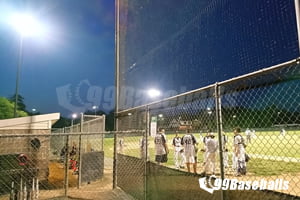


Kane Holland
Wednesday 18th of May 2022
Between pinto and little league baselines stay the same but the distance between home and second changes by 15’. Is it not square anymore or am I missing something?